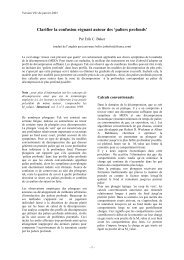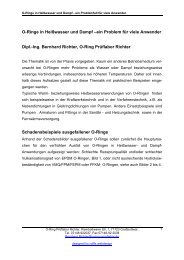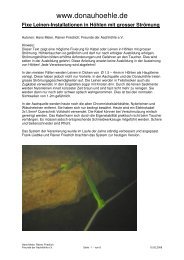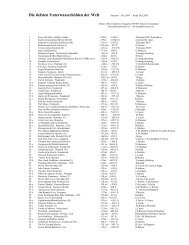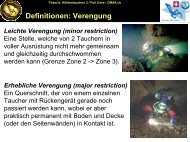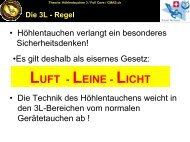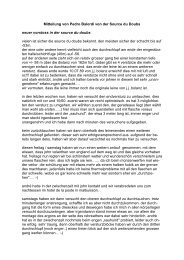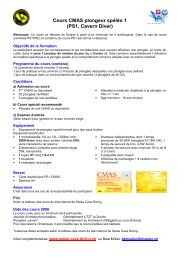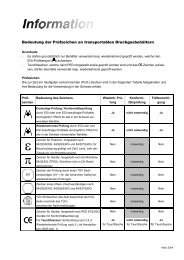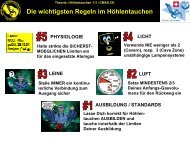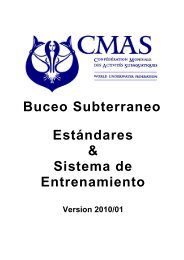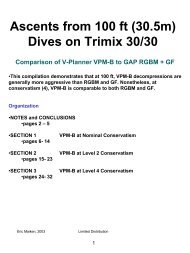cave diving and the nss - bei Swiss-Cave-Diving
cave diving and the nss - bei Swiss-Cave-Diving
cave diving and the nss - bei Swiss-Cave-Diving
You also want an ePaper? Increase the reach of your titles
YUMPU automatically turns print PDFs into web optimized ePapers that Google loves.
48 CAVE DIVING COMMUNICATIONS<br />
REELS AND LINE MARKERS 49<br />
Two or More Teams <strong>and</strong> a Single Primary Reel<br />
On occasion, two or more dive teams will desire to use <strong>the</strong><br />
same primary reel to tie onto <strong>the</strong> permanent guideline. This practice<br />
can eliminate potential entanglements, but it can also create a<br />
mass of confusion between dive teams. Never use ano<strong>the</strong>r<br />
team's primary reel to obtain your continuous guideline to <strong>the</strong><br />
<strong>cave</strong> entrance unless you have first obtained <strong>the</strong> permission<br />
of that team to do so.<br />
Over many years of <strong>cave</strong> <strong>diving</strong>, one of <strong>the</strong> authors has witnessed<br />
several incidents <strong>and</strong> near accidents involving dive teams<br />
that have attempted to share ano<strong>the</strong>r team's primary reel without<br />
first advising <strong>the</strong> original team about <strong>the</strong> decision ahead of time.<br />
There is just no excuse for such a practice. Why jeopardize anyone's<br />
safety for want of a few moment's inconvenience? If two<br />
teams do agree to use <strong>the</strong> same primary reel, <strong>the</strong>n a method of<br />
communicating during <strong>the</strong> dive must be established in order to<br />
avoid confusion during <strong>the</strong> exit. The method proposed utilizes a<br />
clo<strong>the</strong>spin <strong>and</strong> is summarized in <strong>the</strong> following:<br />
1) Prior to entering <strong>the</strong> water, all members of both teams will<br />
mutually agree that more than one team will be using <strong>the</strong> same<br />
primary reel. The specific identification process to be used will<br />
be reviewed.<br />
2) A specific member of each dive team will be assigned <strong>the</strong><br />
responsibility of both installing <strong>and</strong>/or confirming <strong>the</strong> existence,<br />
or lack <strong>the</strong>reof, of <strong>the</strong> clo<strong>the</strong>spin. This is typically <strong>the</strong> second<br />
man of <strong>the</strong> team.<br />
3) The first team to enter <strong>the</strong> <strong>cave</strong> lays <strong>the</strong> primary reel in <strong>the</strong><br />
usual method.<br />
4) The second team to enter adds a clo<strong>the</strong>spin (one that<br />
everybody has seen <strong>and</strong> agreed to beforeh<strong>and</strong>) to <strong>the</strong> exit side<br />
of <strong>the</strong> primary-reel tie-off on top <strong>the</strong> permanent guideline.<br />
5) Whichever team exits <strong>the</strong> <strong>cave</strong> first will remove <strong>the</strong> clip during<br />
<strong>the</strong> exit. This responsibility is usually assigned to <strong>the</strong> second<br />
man of <strong>the</strong> dive team. When <strong>the</strong> second man sees <strong>the</strong> clip he<br />
notifies <strong>the</strong> reel man to leave <strong>the</strong> primary reel, <strong>the</strong>n picks up<br />
<strong>the</strong> clip. If no clip is observed, <strong>the</strong> second man notifies <strong>the</strong> reel<br />
man that no clip exists <strong>and</strong> that <strong>the</strong> reel man should remove<br />
<strong>the</strong> primary reel.<br />
Primary-reel<br />
tie-off onto<br />
permanently installed<br />
line with clo<strong>the</strong>spin<br />
added by second team<br />
Should two teams agree to use <strong>the</strong><br />
same primary reel at <strong>the</strong> same time, <strong>the</strong> second<br />
team must announce its presence to <strong>the</strong> first<br />
team. This is done by <strong>the</strong> second team (<strong>and</strong> each<br />
additional team) adding a pre-agreed-to clo<strong>the</strong>spin to<br />
<strong>the</strong> outbound side of <strong>the</strong> primary-reel tie-in point. As each<br />
team exits, a clo<strong>the</strong>spin is removed. The final returning team,<br />
finding no clo<strong>the</strong>spins, will remove <strong>the</strong> reel in <strong>the</strong> usual manner.<br />
Before undertaking this identification system, each team must<br />
agree to <strong>the</strong> procedures, type of clip to be installed, <strong>and</strong> <strong>the</strong><br />
specific diver (typically <strong>the</strong> second man) from each team<br />
to add or remove clips from <strong>the</strong> guideline.<br />
6) The last team to exit <strong>the</strong> <strong>cave</strong>, seeing that <strong>the</strong>re are no clo<strong>the</strong>spins,<br />
will remove <strong>the</strong> primary reel in <strong>the</strong> usual manner.<br />
7) Should any doubt remain concerning <strong>the</strong> whereabouts of any<br />
o<strong>the</strong>r team, <strong>the</strong>n leave <strong>the</strong> primary reel for later retrieval. Take<br />
no chances with anyone's safety.<br />
GAP REELS<br />
Gap reels are used to connect two permanent guidelines<br />
toge<strong>the</strong>r. Generally this implies joining <strong>the</strong> end of one permanent<br />
guideline to <strong>the</strong> beginning of ano<strong>the</strong>r, <strong>and</strong> <strong>the</strong>re are no directional<br />
decisions to be made. Typically, one begins by looping <strong>the</strong> line<br />
from <strong>the</strong> gap reel over <strong>the</strong> end of <strong>the</strong> permanent line, <strong>the</strong>n over <strong>the</strong>




